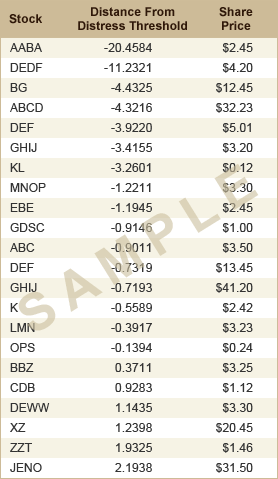Enter a stock symbol
Enter a stock symbol to view that company's Altman Z-Score if it is a manufacturing company, or its Altman Z"-Score, if it is a non-financial, non-manufacturing company, and to view message board posts for that stock (Scores are available for premium members).
Screener
Below is a list of today's twenty-five most distressed stocks (according to their Altman Z-Score or Z''-Score, respectively) with a share price of $5 or higher. For details on how this ranking list is compiled, please click here.



Stock Chart
Flash Player 9 or higher is required to view the chart
Click here to download Flash Player now
SPY - Comparing Secular Bear Markets
Interesting chart via Tim Knight from Martin Ping, comparing where we are today versus the average secular bear market: http://slopeofhope.com...
Submit a comment
In order to comment please sign in.
Dave, how long have you been interested or using technical analysis for your investing decisions? I've been reading your blog basically since you started it on blogspot or wherever the DaveInHackensack one was hosted. From my perspective, it seems your long versus short investment decisions seem a little...schizophrenic...in their bases (and I'm not trying to insult you).
For instance, most of your long investments (or at least the ones you've discussed on your blog(s)) seem to have as their bases some type of fundamental analysis combined with a more macro themed view. On the other hand, for your shorts, it really seems like most of the basis for picking them have been based on a combination of technical analysis, combined sometimes with poor Altman scores, and a conviction that we are in a secular bear market. At least, that is all the bases I have been able to glean from your admittedly short blog posts. It seems that a decision to short any particular stock has had little to do with an evaluation of the companies fundamentals (other than perhaps a belief that you think the industry is in bad shape).
Do you agree? Is this intentional? The reason I used the word schizophrenic originally is that it seemed that your long investments have really been based on a fundamental analysis while your short ones have been mostly a result of a technical analysis.
I am agnostic as to technical analysis. I think it certainly has utility, along the lines of what Katsenelson said, but I am a little uncomfortable using it in a way that seems to ignore (or at least give short shrift to) fundamentals. Certainly picking short candidates during what may be a secular bear market may be successful, but I wonder whether it may be because of that secular trend, and not as much to do with technical bases. For example, I wonder whether your bases for picking shorts would do very well in a period from say, 2003-2007 when the market was trending up. I only raise this issue because I wasn't sure whether you consider the interactions between the market we're in, the technical analysis you were using, and the fact that you seem to be using that combination for picking short candidates (as opposed to long ones).
Homer, I've been thinking more about technical analysis over the last year or so. I always thought it made sense as a complement to fundamental investing (e.g., figuring out entry points), but I didn't use it as much as I should have.
Your characterization of my "schizophrenia" here is mostly on target. A few points worth elaborating on though. My decisions to short are based not just on the belief that we are in a secular bear market, but that we have entered a cyclical bear market phase of it. I didn't do as much shorting earlier this year, during the cyclical bull phase, and, in at least a couple occasions, I balanced out a short with a long in the same industry for a pairs trade to avoid adding net short exposure.
My sense now is that we are in a cyclical bear phase that started at the end of April. It's been pretty choppy, which has lead to me getting stopped out of shorts frequently, but I suspect that the market will rollover at some point and become less choppy, and whatever shorts I hold then will be well-positioned for some attractive gains.
I still look at macro trends and fundamentals for shorts. Bear in mind that the Altman models are almost entirely fundamental, so a company with a weak score will generally have weak fundamentals. I put more weight into technicals for shorts because that's the M.O. of successful shorts I am familiar with such as Tim Knight and William O'Neil.
I don't think any kind of pure shorting strategy would have done well during the cyclical bull marked from the end of 2002 to 2007. Short Screen member Marc Mayor did well during that time frame with a market neutral strategy (half long, half short), but I don't think there's much benefit to being significantly net short during a cyclical bull market.
Shorting is a different animal, but there's probably a bigger distinction in how I view a potential multi-bagger conviction hold such as AYSI and a long position I have less conviction in. During the first few months of the year, I put stops on most of my non-conviction stocks and let myself get stopped out of them. In contrast, I'm willing to watch an AYSI drop (provided the thesis appears intact), because I view even a steep decline as less of a risk than missing out on a huge upside (e.g., if some big contract were announced the day I sold).
On the other hand, there seems to be less benefit to riding a stock like WMT down.
Fair enough. At least it wasn't my imagination. I've been reading Piotroski's paper on Value Investing from January 2002 ("Value Investing: The use of historical financial statement information to separate winners from losers") and was thinking about your shortscreen site (which I have yet to subscribe to). I was look at the paper because I have been thinking of using his screen to find some potential long investments. Anyway, one of the things I noticed in reading the paper is that he looked at whether firms that had low scores (i.e. scores that indicate the stock may not be a good investments) had a larger chance of being de-listed for performance reasons. It turns out that there was basically a linear relationship between scores and both return on assets a year later, and delisting a year later. That is to say, high scoring firms ended up having a higher ROA at T+1 (more profitable) and lowest scoring firms had a five times higher rate of delisting for performance reasons. You might think about combining the z-score with the piotroski score in order to find even better short candidates.
Incorporating some elements of Piotroski might not be a bad idea for a future addition to Short Screen. One thing Altman and Piotroski have in common is that both models have been used to construct successful market neutral strategies (in Piotroski's case, it was his own idea to make a market neutral strategy out of it). I've also thought of adding a technical component here. I usually start with the Altman screener than look at some technical indicators; maybe that could get built in here at some point.
There are a couple of other development projects ahead of it in the queue though, including an iPhone app based on Portfolio Armor.
Hi Homer,
I've found going short and going long require different mentalities, because they are not the same thing. Here is an excerpt from an email exchange I had with Dave recently explaining the evolution of my own thought process:
"Like you, I've grown fond of stops with my shorts. I guess I could have listened to you from the beginning, but then I probably would have never really learned it to begin with! One thing that took time for me to appreciate is how shorting truly is the inverse of long in every respect. With time, losses accelerate in shorts, they diminish with longs. Gains accelerate in longs and are front-loaded with shorts. Shorts are best for market timing, with the profits front-loaded, longs are best for...well, long-term compounding.
i.e. If you buy a stock for one dollar, every dollar above that is another 100% gain. For a short of that stock, each dollar gain would be a loss of 100%. With a stock going down, a long's losses form an asymptote approaching 0, while a shorts form one as they approach 100%. Hence, it doesn't make much sense to sit on a short once you have the meat of your profits. Whereas with longs you want to let your winners ride. There are lots of crappy companies to short and only a few worthwhile to hold on to...so on and so forth."
^A bit discursive and unpolished (Hey I'm not the blogger here), but I hope that helps some.
And as dave mentioned, by using the Altman Z score, one is not eschewing the fundamental side. The thing is, there are a LOT of companies on shaky ground. It's not hard to find them! They are not hard to identify, unlike finding 'hidden value' in the market. The problem thus becomes, when do you short? And that's where TA comes into play. Towards the end of the secular bear market, there probably won't be much of a market for crappy companies, so finding indebted, stagnating stocks to short might require more analysis then.